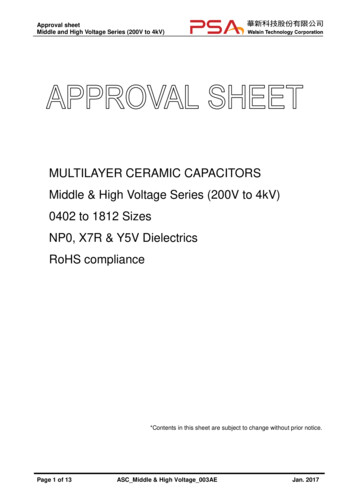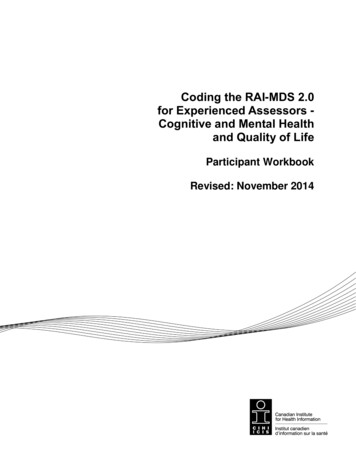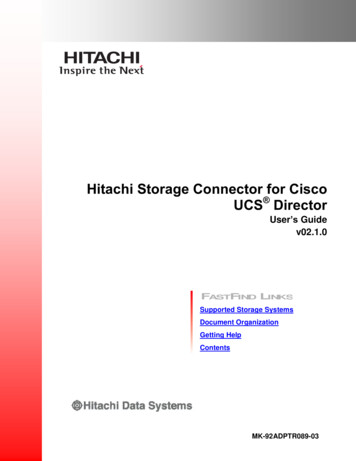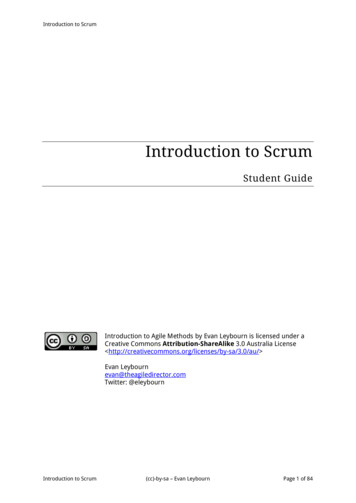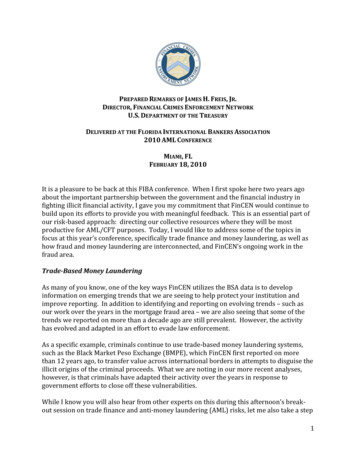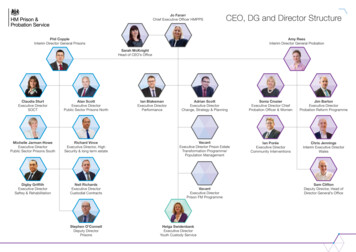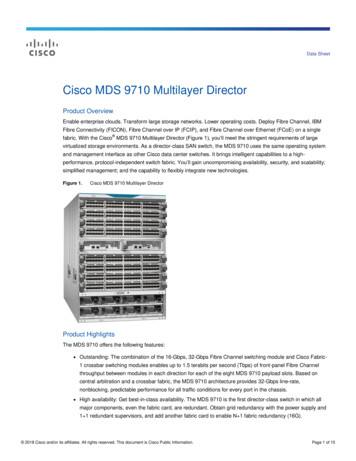
Transcription
Data SheetCisco MDS 9710 Multilayer DirectorProduct OverviewEnable enterprise clouds. Transform large storage networks. Lower operating costs. Deploy Fibre Channel, IBMFibre Connectivity (FICON), Fibre Channel over IP (FCIP), and Fibre Channel over Ethernet (FCoE) on a singlefabric. With the Cisco MDS 9710 Multilayer Director (Figure 1), you’ll meet the stringent requirements of largevirtualized storage environments. As a director-class SAN switch, the MDS 9710 uses the same operating systemand management interface as other Cisco data center switches. It brings intelligent capabilities to a highperformance, protocol-independent switch fabric. You’ll gain uncompromising availability, security, and scalability;simplified management; and the capability to flexibly integrate new technologies.Figure 1.Cisco MDS 9710 Multilayer DirectorProduct HighlightsThe MDS 9710 offers the following features: Outstanding: The combination of the 16-Gbps, 32-Gbps Fibre Channel switching module and Cisco Fabric1 crossbar switching modules enables up to 1.5 terabits per second (Tbps) of front-panel Fibre Channelthroughput between modules in each direction for each of the eight MDS 9710 payload slots. Based oncentral arbitration and a crossbar fabric, the MDS 9710 architecture provides 32-Gbps line-rate,nonblocking, predictable performance for all traffic conditions for every port in the chassis. High availability: Get best-in-class availability. The MDS 9710 is the first director-class switch in which allmajor components, even the fabric card, are redundant. Obtain grid redundancy with the power supply and1 1 redundant supervisors, and add another fabric card to enable N 1 fabric redundancy (16G). 2018 Cisco and/or its affiliates. All rights reserved. This document is Cisco Public Information.Page 1 of 15
The MDS 9710 combines nondisruptive software upgrades, stateful process restart and failover, and fullredundancy of all major components for best-in-class availability. Industry-leading scalability: Power the largest storage environments with up to 24 Tbps of Fibre Channelbandwidth. A single chassis delivers 384 2/4/8-Gbps, 4/8/16-Gbps, 8/16/32-Gbps or 10-Gbps full line-rateautosensing Fibre Channel ports, and a single rack supports up to 1152 Fibre Channel ports. Intelligent network services: Migrate your SAN islands to enterprisewide storage networks with VSANtechnology, access control lists (ACLs) for hardware-based intelligent frame processing, and fabricwidequality of service (QoS). Integrated hardware-based VSANs and Inter-VSAN Routing (IVR): Integration of VSANs into port-levelhardware allows any port in a system or fabric to be partitioned to any VSAN. Deliver line-rate routingbetween any ports in a system or fabric without the need for external routing appliances. Intelligent storage services: Interoperability with intelligent service capabilities on other Cisco MDS 9000Family platforms and the intelligent services switch provides services such as acceleration of storageapplications for data replication, backup, and data migration to hosts and targets. Smart zoning: Efficiently provision hardware access control entries specified by the zone set. Matchsmart zones to applications, application clusters, hypervisor clusters, or other data center entities. Avoidsuperfluous entries that allow servers (initiators) to talk to other servers or storage devices (targets) totalk to other storage devices. You’ll gain larger zones with multiple initiators and targets withoutconsuming excessive hardware resources. Automate zoning tasks and avoid creating many small zones. Virtual machine transparency: Deterministic hardware performance and a comprehensive feature set allowvirtual machines to have the same SAN attributes as a physical server. On a per-virtual machine basis, theCisco NX-OS Software offers VSANs, QoS policies, access control, performance monitoring, and dataprotection to promote the scalability and mobility of virtual machines. Cisco Prime Data Center NetworkManager (DCNM) provides end-to-end visibility all the way from the virtual machine down to the storageresource, with resource allocation, performance measurements, and predictions available on a per-virtualmachine basis to enable rapid troubleshooting in mission-critical virtualized environments. Comprehensive security: In addition to support for services such as VSANs, hardware-enforced zoning,ACLs, per-VSAN role-based access control (RBAC), and Cisco TrustSec Fibre Channel link encryption,Cisco MDS 9700 Series Multilayer Directors support a comprehensive security framework consisting ofRADIUS and TACACS , Fibre Channel Security Protocol (FC-SP), Secure File Transfer Protocol (SFTP),Secure Shell (SSH) Protocol, and Simple Network Management Protocol Version 3 (SNMPv3). CiscoTrustSec Fibre Channel link encryption delivers transparent, hardware-based 16-Gbps or 32-Gbps line-rateencryption of Fibre Channel data in addition to 10-Gbps line-rate encryption. Unified SAN management: The MDS 9700 Series includes built-in storage network management with allfeatures available through a command-line interface (CLI) or Cisco Prime DCNM, a centralizedmanagement tool that simplifies management of unified fabrics. DCNM supports integration with third-partystorage management applications to allow transparent interaction with existing management tools. DCNMsupports federation of up to 10 DCNM servers to manage up to 150,000 devices using a singlemanagement pane. 2018 Cisco and/or its affiliates. All rights reserved. This document is Cisco Public Information.Page 2 of 15
Sophisticated diagnostics: Intelligent diagnostics, protocol decoding, network analysis tools and the CiscoCall Home capability give you reliability, faster problem resolution, and reduced service costs. Starting withCisco MDS 9000 NX-OS Release 6.2, the Cisco Generic Online Diagnostics (GOLD) framework replacesthe Cisco Online Health Management System (OHMS) diagnostic framework on the new MDS 9700 Serieschassis. GOLD is a suite of diagnostic tools that you can use to verify that hardware and internal data pathsare operating properly. It offers boot-time diagnostics, continuous monitoring, standby fabric loopback tests,and on-demand and scheduled tests. Enable the rapid fault isolation and system monitoring that are criticalin today's continuously operating environments. Multiprotocol architecture: A multilayer architecture enables a consistent feature set over a protocolindependent switch fabric. The MDS 9710 transparently integrates Fibre Channel, FCoE, and FICON. 2/4/8-Gbps, 4/8/16-Gbps, 8/16/32-Gbps, 10-Gbps Fibre Channel, and 10 Gigabit Ethernet: The MDS9710 supports 2/4/8/16-Gbps and 10-Gbps ports on the Cisco MDS 9700 48-Port 16-Gbps FibreChannel Switching Module for both open-systems and FICON environments. The MDS 9710 alsosupports 10 Gigabit Ethernet clocked optics carrying Fibre Channel traffic. The MDS 9710 supports4/8/16/32-Gbps on the Cisco MDS 9700 48-Port 32-Gbps Fibre Channel Switching Module. FICON: The MDS 9710 is mainframe ready and supports for IBM System z FICON and Linuxenvironments. Multihop FCoE: Extend connectivity from FCoE and Fibre Channel fabrics to FCoE and Fibre Channelstorage devices. SAN Extension FCIP support: The Cisco MDS 9000 24/10-Port SAN Extension Module is supported onMDS 9700 Series Multilayer Directors. With 24 line-rate 2/4/8/10/16-Gbps Fibre Channel ports and eight1 and 10 Gigabit Ethernet FCIP ports, this module enables deployment of large and scalable SANextension solutions.Main BenefitsReduce Total Cost of Ownership with SAN ConsolidationWith the amount of data growing exponentially, organizations need efficent, cost-effective, large-scale SANs. Scalewhile managing your total cost of ownership (TCO) with industry-leading port densities of up to 384 32-Gbps FibreChannel ports per chassis. Deploy 1.5-Tbps front-panel Fibre Channel performance per slot and up to 24-Tbpsfront-panel Fibre Channel line-rate nonblocking system-level switching. Deploy intelligent fabric services, VSANsfor consolidating physical SAN islands while maintaining logical boundaries, and IVR for sharing resources acrossVSANs. Consolidate your data into fewer, larger, and more manageable SANs, thus reducing the hardwarefootprint and associated capital expenditures (CapEx) and operating expenses (OpEx). On unified fabrics withconverged LAN and SAN environments using lossless Ethernet, multihop FCoE protects your investments inexisting storage infrastructure with any-to-any connectivity across multiple protocols.Enterprise-Class AvailabilityThe MDS 9710 is designed from the beginning for high availability. In addition to meeting the basic requirements ofnondisruptive software upgrades and redundancy of all critical hardware components, the MDS 9710 softwarearchitecture offers outstanding availability. The Cisco MDS 9700 Series Supervisor-1 Module automatically restartsfailed processes, making the MDS 9710 exceptionally robust. In the rare event that a supervisor module is reset,complete synchronization between the active and standby supervisor modules helps ensure stateful failover withno disruption of traffic. 2018 Cisco and/or its affiliates. All rights reserved. This document is Cisco Public Information.Page 3 of 15
The MDS 9710 is the first in the industry to provide redundency on all major hardware components, as detailed inTable 1.Table 1.Cisco MDS 9710 RedundancyComponentRedundancySupervisors1 1Power suppliesGrid redundancyFabricsN 1 redundancyHigh availability is implemented at the fabric level using robust and high-performance Inter-Switch Links (ISLs).The port-channel capability allows you aggregate up to 16 physical links into one logical bundle. The bundle canconsist of any speed-matched ports in the chassis, helping ensure that the bundle can remain active in the event ofa port, application-specific integrated circuit (ASIC), or module failure. ISLs in a port channel can have significantlydifferent lengths. This capability is valuable in campus and metropolitan area network (MAN) environments,because logical links can now be spread over multiple physical paths, helping ensure uninterrupted connectivityeven if one of the physical paths is disrupted. The MDS 9710 provides outstanding high availability, helping ensurethat solutions exceed the 99.999 percent uptime requirements of today’s most demanding environments.Business Transformation with Enterprise Cloud DeploymentWith industry-leading scalability and pay-as-you-grow flexibility, the MDS 9710 enables you to quickly scaleenterprise clouds up or down as needed. You also receive these benefits: Multihop FCoE provisions storage in a multiprotocol unified fabric. Robust security protects multitenancy cloud applications. Predictable high performance meets stringent service-level agreements (SLAs). Resilient connectivity helps ensure always-on cloud infrastructure. Advanced traffic management capabilities, such as QoS, quickly and cost-efficiently allocate elastic networkcapabilities to cloud applications.Furthermore, Cisco Prime DCNM provides resource monitoring and capacity planning on a per-virtual machinebasis. You can efficiently: Consolidate enterprise cloud deployments Federate up to 10 DCNM servers to easily manage large-scale clouds Use information through Storage Management Initiative Specification (SMI-S)–based developer APIs todeliver IT as a serviceAdvanced Traffic ManagementDeploy and optimize large-scale fabrics more easily: Virtual output queue (VOQ): Help ensure line-rate performance on each port, independent of traffic pattern,by eliminating head-of-line blocking. Up to 4095 buffer-to-buffer credits: Using extended credits, allocate up to 4095 buffer credits from a pool ofmore than 6000 buffer credits for a module to ports as needed to greatly extend the distance for FibreChannel SANs. Alternatively, assign up to 4095 buffer credits to an individual port for optimal bandwidthutilization across distances. 2018 Cisco and/or its affiliates. All rights reserved. This document is Cisco Public Information.Page 4 of 15
Port channels: Aggregate up to 16 physical ISLs into a single logical bundle, providing optimized bandwidthutilization across all links. The bundle can consist of any speed-matched ports from any module in thechassis, helping ensure that the bundle can remain active even in the event of a module failure. The MDS9000 Family switch architecture helps ensure that frames can never be reordered within a switch. Fabric Shortest Path First (FSPF)–based multipathing: Provide the intelligence to load-balance traffic acrossup to 16 Fibre Channel or FCoE equal-cost paths and, in the event of a switch failure, dynamically reroutetraffic. QoS: Use QoS to manage bandwidth and control latency to prioritize critical traffic.Ease of ManagementThe MDS 9710 provides three modes of management: the MDS 9000 Family CLI, Cisco Prime DCNM, andintegration with third-party storage management tools.Adhering to the syntax of the widely known Cisco IOS Software CLI, the MDS 9000 Family CLI is consistent andeasy to learn and delivers broad management capabilities. The MDS 9000 Family CLI provides optimalcapabilities: for instance, you can enable debugging modes for each switch feature and view a real-time updatedactivity log of control protocol exchanges. Log entries are time-stamped and listed in chronological order.Cisco Prime DCNM is the network’s industry’s first converged SAN and LAN management solution. It lets youmanage all NX-OS devices, including the MDS 9000 Family and Cisco Nexus Family products. Its intuitive GUIsimplifies day-to-day operations of Cisco unified fabrics in virtualized data center environments.DCNM offers such functions as: Monitoring of events and performance historically and at scale Wizard- and template-based provisioning of NX-OS technologies and services Cisco VMpath analytics, with dynamic topology views for extended visibility into virtual infrastructure Resource management through trend analysis of inventory and performance Rule-based event notification and filtering RBAC to provide separation between network and storage teamsYou can scale to large deployments through scale-out server architecture with automated failover capability.Provide a resilient management system that centralizes infrastructure and path monitoring across geographicallydispersed data centers. The DCNM base management function is available at no charge, and advanced featuresare unlocked with a license. The application can be installed on Linux and Microsoft Windows operating systemsand supports both PostgreSQL and Oracle databases.Comprehensive Solution for Robust SecurityThe extensive security framework of the MDS 9710 protects sensitive data crossing enterprise networks. Itprovides intelligent, port-level packet inspection, including the use of ACLs for hardware enforcement of zones,VSANs, and advanced port security features. VSANs are used to achieve greater security and stability by providingcomplete isolation of devices that are connected to the same physical SAN. IVR enables controlled sharing ofresources between VSANs. In addition, FC-SP provides switch-to-switch and host-to-switch Diffie-HellmanChallenge Handshake Authentication Protocol (DH-CHAP) support for RADIUS and TACACS . This feature helpsensure that only authorized devices access protected storage networks. To further protect traffic within andbetween data centers, Cisco TrustSec Fibre Channel link encryption, available in the MDS 9700 Series 16-Gbpsand 32-Gbps modules, lets you transparently encrypt ISLs at up to line-rate speeds. 2018 Cisco and/or its affiliates. All rights reserved. This document is Cisco Public Information.Page 5 of 15
Advanced Diagnostics and Troubleshooting ToolsTo manage large-scale storage networks, you need proactive diagnostics tools, tools to verify connectivity androute latency, and traffic analysis tools. We deliver a comprehensive tool set for analyzing, troubleshooting, anddebugging storage networks. Power-on self-test (POST) and online diagnostics proactively monitor system health.Identify the exact path and timing of flows with capabilities such as Fibre Channel traceroute. Capture networktraffic using Cisco Switched Port Analyzer (SPAN) and Remote SPAN (RSPAN). Then analyze traffic with theCisco Fabric Analyzer, an embedded Fibre Channel analyzer. You’ll gain sophisticated performance analysis andSLA accounting capabilities by collecting port-based and flow-based statistics.Convergence with Multihop FCoEFCoE allows an evolutionary approach to network and I/O convergence. Preserve all Fibre Channel constructs;maintain the latency, security, and traffic management attributes of Fibre Channel; and preserve your investmentsin Fibre Channel tools, training, and SANs. Sharing the same operating system and management plane as theCisco Nexus switches, the MDS 9710 coexists invisibly in a unified fabric with any-to-any connectivity for FibreChannel and FCoE.Integrated Mainframe SupportThe MDS 9710 fully supports IBM System z FICON and Linux environments. It supports FICON protocol transportin both cascaded and noncascaded fabrics, as well as an intermix of FICON and open-systems Fibre ChannelProtocol (FCP) traffic on the same switch. IBM Control Unit Port (CUP) enables in-band management of MDS 9000Family switches from mainframe management applications. A fabric-binding feature helps ensure that ISLs areenabled only between specified switches in the fabric-binding configuration.Product SpecificationsTable 2 lists the product specifications for the MDS 9710 Multilayer Director.Table 2.Technical SpecificationsFeatureDescriptionProduct compatibilityCisco MDS 9000 FamilySoftware compatibility Cisco MDS NX-OS Software Release 6.2.1 or laterIndicatorsPower supply LEDFAN LEDSupervisor LEDFabric LEDLine-card module LEDProtocols Fibre Channel standards FC-PH, Revision 4.3 (ANSI INCITS 230-1994) FC-PH, Amendment 1 (ANSI INCITS 230-1994/AM1-1996) FC-PH, Amendment 2 (ANSI INCITS 230-1994/AM2-1999) FC-PH-2, Revision 7.4 (ANSI INCITS 297-1997) FC-PH-3, Revision 9.4 (ANSI INCITS 303-1998) FC-PI, Revision 13 (ANSI INCITS 352-2002) FC-PI-2, Revision 10 (ANSI INCITS 404-2006) FC-PI-3, Revision 4 (ANSI INCITS 460-2011) FC-PI-4, Revision 8 (ANSI INCITS 450-2008) FC-PI-5, Revision 6 (ANSI INCITS 479-2011) FC-FS, Revision 1.9 (ANSI INCITS 373-2003) FC-FS-2, Revision 1.01 (ANSI INCITS 424-2007) FC-FS-2, Amendment 1 (ANSI INCITS 424-2007/AM1-2007) 2018 Cisco and/or its affiliates. All rights reserved. This document is Cisco Public Information.Page 6 of 15
FeatureDescription FC-FS-3, Revision 1.11 (ANSI INCITS 470-2011) FC-LS, Revision 1.62 (ANSI INCITS 433-2007) FC-LS-2, Revision 2.21 (ANSI INCITS 477-2011) FC-SW-2, Revision 5.3 (ANSI INCITS 355-2001) FC-SW-3, Revision 6.6 (ANSI INCITS 384-2004) FC-SW-4, Revision 7.5 (ANSI INCITS 418-2006) FC-SW-5, Revision 8.5 (ANSI INCITS 461-2010) FC-GS-3, Revision 7.01 (ANSI INCITS 348-2001) FC-GS-4, Revision 7.91 (ANSI INCITS 387-2004) FCP, Revision 12 (ANSI INCITS 269-1996) FCP-2, Revision 8 (ANSI INCITS 350-2003) FCP-3, Revision 4 (ANSI INCITS 416-2006) FCP-4, Revision 2b (ANSI INCITS 481-2011) FC-SB-2, Revision 2.1 (ANSI INCITS 349-2001) FC-SB-3, Revision 1.6 (ANSI INCITS 374-2003) FC-SB-3, Amendment 1 (ANSI INCITS 374-2003/AM1-2007) FC-SB-4, Revision 3.0 (ANSI INCITS 466-2011) FC-SB-5, Revision 2.00 (ANSI INCITS 485-2014) FC-BB-6, Revision 2.00 (ANSI INCITS 509-2014) FC-BB-2, Revision 6.0 (ANSI INCITS 372-2003) FC-BB-3, Revision 6.8 (ANSI INCITS 414-2006) FC-BB-4, Revision 2.7 (ANSI INCITS 419-2008) FC-BB-5, Revision 2.0 (ANSI INCITS 462-2010) FC-VI, Revision 1.84 (ANSI INCITS 357-2002) FC-SP, Revision 1.8 (ANSI INCITS 426-2007) FC-SP-2, Revision 2.71 (ANSI INCITS 496-2012) FAIS, Revision 1.03 (ANSI INCITS 432-2007) FAIS-2, Revision 2.23 (ANSI INCI
Data Sheet Cisco MDS 9710 Multilayer Director Product Overview Enable enterprise clouds. Transform large storage networks. Lower operating costs. Deploy Fibre Channel, IBM Fibre Connectivity (FICON), Fibre Channel over IP (FCIP), a

